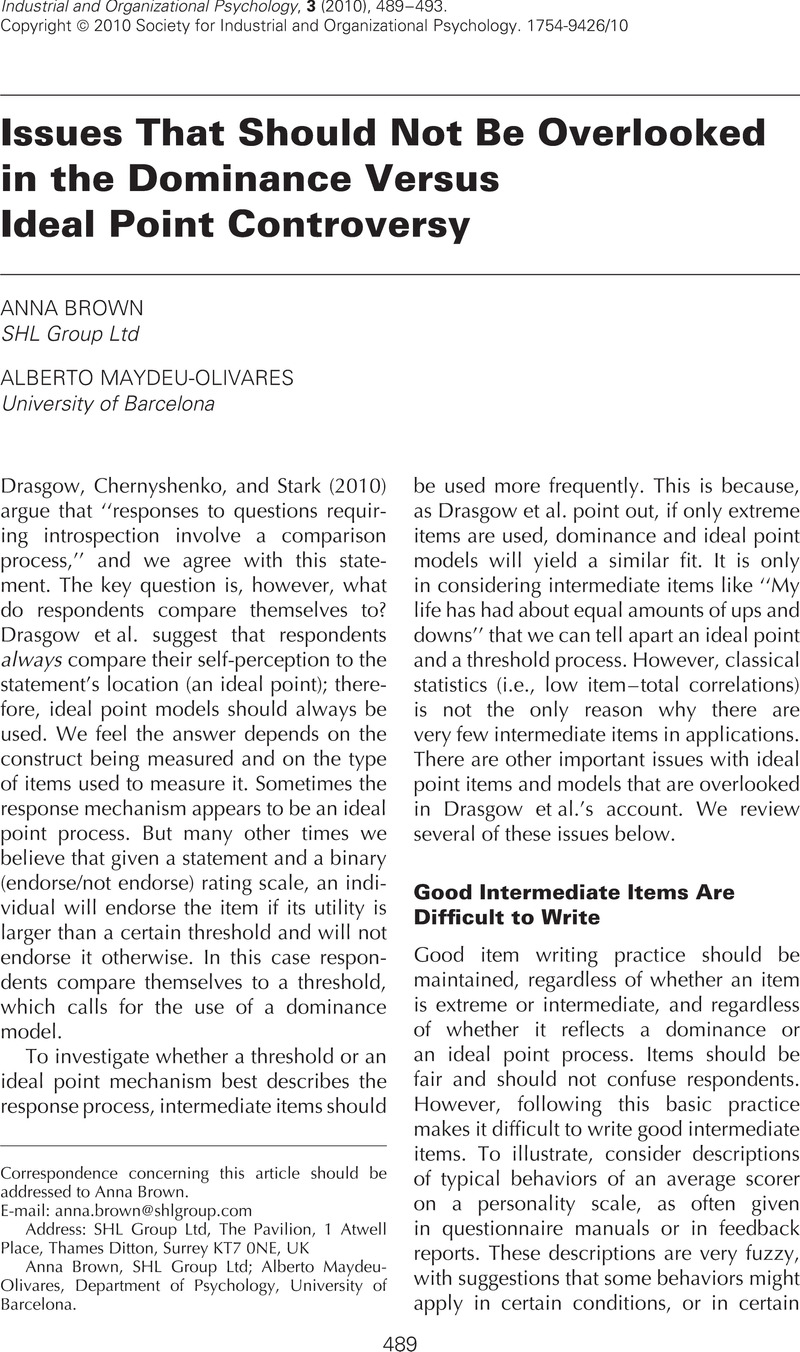Crossref Citations
This article has been cited by the following publications. This list is generated based on data provided by Crossref.
Drasgow, Fritz
Chernyshenko, Oleksandr S.
and
Stark, Stephen
2010.
Improving the Measurement of Psychological Variables: Ideal Point Models Rock!.
Industrial and Organizational Psychology,
Vol. 3,
Issue. 4,
p.
515.
Park, DongGun
Choi, MyungOk
Lee, WonSun
Lee, HyeMin
and
Lee, JunHee
2012.
Comparison between dominance process model and ideal point response model for personality assesment.
Korean Journal of Industrial and Organizational Psychology,
Vol. 25,
Issue. 2,
p.
421.
Brown, Anna
2015.
International Encyclopedia of the Social & Behavioral Sciences.
p.
840.
Cao, Mengyang
Drasgow, Fritz
and
Cho, Seonghee
2015.
Developing Ideal Intermediate Personality Items for the Ideal Point Model.
Organizational Research Methods,
Vol. 18,
Issue. 2,
p.
252.
Van Geert, Eline
Orhon, Altan
Cioca, Iulia A.
Mamede, Rui
Golušin, Slobodan
Hubená, Barbora
and
Morillo, Daniel
2016.
Study Protocol on Intentional Distortion in Personality Assessment: Relationship with Test Format, Culture, and Cognitive Ability.
Frontiers in Psychology,
Vol. 7,
Issue. ,
Morillo, Daniel
Leenen, Iwin
Abad, Francisco J.
Hontangas, Pedro
de la Torre, Jimmy
and
Ponsoda, Vicente
2016.
A Dominance Variant Under the Multi-Unidimensional Pairwise-Preference Framework.
Applied Psychological Measurement,
Vol. 40,
Issue. 7,
p.
500.
Brown, Anna
2016.
Item Response Models for Forced-Choice Questionnaires: A Common Framework.
Psychometrika,
Vol. 81,
Issue. 1,
p.
135.
Murray, Aja Louise
Booth, Tom
and
Molenaar, Dylan
2016.
When Middle Really Means “Top” or “Bottom”: An Analysis of the 16PF5 Using Bock's Nominal Response Model.
Journal of Personality Assessment,
Vol. 98,
Issue. 3,
p.
319.
Vergauwe, Jasmine
Wille, Bart
Hofmans, Joeri
Kaiser, Robert B.
and
Fruyt, Filip De
2017.
The Too Little/Too Much Scale.
Organizational Research Methods,
Vol. 20,
Issue. 3,
p.
518.
Brown, Anna
and
Maydeu‐Olivares, Albert
2018.
The Wiley Handbook of Psychometric Testing.
p.
523.
Eliasz, Kinga L.
Ark, Tavinder K.
Nick, Michael W.
Ng, Grace M.
Zabar, Sondra
and
Kalet, Adina L.
2018.
Capturing Entrustment: Using an End-of-Training Simulated Workplace to Assess the Entrustment of Near-graduating Medical Students from Multiple Perspectives.
Medical Science Educator,
Vol. 28,
Issue. 4,
p.
739.
McGrane, Joshua A.
2019.
The Bipolarity of Attitudes: Unfolding the Implications of Ambivalence.
Applied Psychological Measurement,
Vol. 43,
Issue. 3,
p.
211.
Liu, Jie
and
Zhang, Jinfu
2020.
An Item-Level Analysis for Detecting Faking on Personality Tests: Appropriateness of Ideal Point Item Response Theory Models.
Frontiers in Psychology,
Vol. 10,
Issue. ,
Lee, Philseok
Joo, Seang-Hwane
and
Stark, Stephen
2021.
Detecting DIF in Multidimensional Forced Choice Measures Using the Thurstonian Item Response Theory Model.
Organizational Research Methods,
Vol. 24,
Issue. 4,
p.
739.
Verkuilen, Jay
2022.
The Fisher information function and scoring in binary ideal point item response models: a cautionary tale.
British Journal of Mathematical and Statistical Psychology,
Vol. 75,
Issue. 1,
p.
182.
LIU, Juan
ZHENG, Chanjin
LI, Yunchuan
and
LIAN, Xu
2022.
IRT-based scoring methods for multidimensional forced choice tests.
Advances in Psychological Science,
Vol. 30,
Issue. 6,
p.
1410.
Kreitchmann, Rodrigo Schames
Abad, Francisco J.
and
Sorrel, Miguel A.
2022.
A genetic algorithm for optimal assembly of pairwise forced-choice questionnaires.
Behavior Research Methods,
Vol. 54,
Issue. 3,
p.
1476.
Lin, Yin
Brown, Anna
and
Williams, Paul
2023.
Multidimensional Forced-Choice CAT With Dominance Items: An Empirical Comparison With Optimal Static Testing Under Different Desirability Matching.
Educational and Psychological Measurement,
Vol. 83,
Issue. 2,
p.
322.
Nie, Lei
Xu, Peiyi
and
Hu, Di
2024.
Multidimensional IRT for forced choice tests: A literature review.
Heliyon,
Vol. 10,
Issue. 5,
p.
e26884.
Liu, Kai
Zheng, Yi
Wang, Daxun
Cai, Yan
Shi, Yuanyuan
Xi, Chongqin
and
Tu, Dongbo
2024.
A Framework for Detecting Both Main Effect and Interactive DIF in Multidimensional Forced-Choice Assessments.
Organizational Research Methods,





